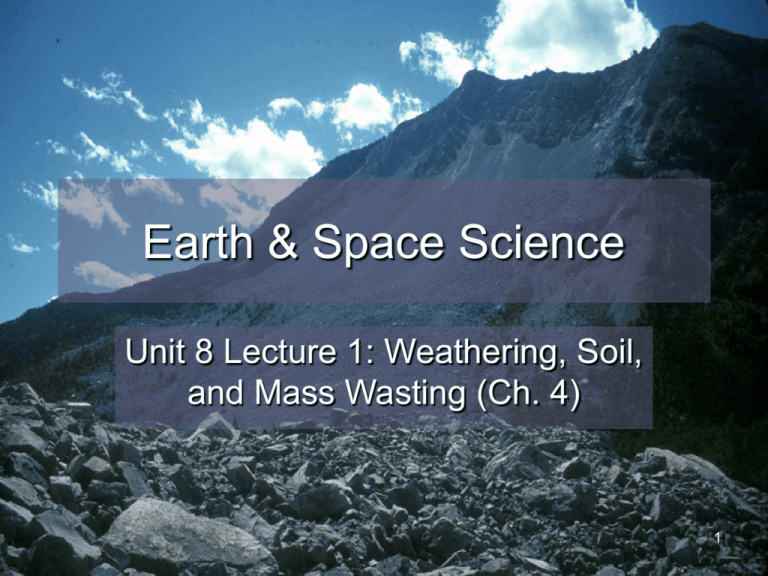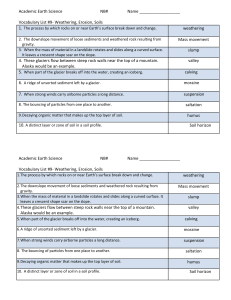File
advertisement

Earth & Space Science Unit 8 Lecture 1: Weathering, Soil, and Mass Wasting (Ch. 4) 1 Earth’s External Process • • Called external because they occur at or near Earth’s surface Three types: – Weathering – Mass Wasting – Erosion 2 Weathering • Two kinds of weathering 1. Mechanical weathering 2. Chemical Weathering 3 Mechanical Weathering • • Breaking of rocks into smaller pieces Four Processes – – – – Frost wedging Unloading Thermal expansion Biological activity 4 Mechanical Weathering (cont.) 5 Frost Wedging 1. Frost wedging on a talus slope 2. Picture of a real talus slope (on next slide) 6 7 Unloading 1. Half Dome, Yosemite National Park 2. Exfoliation of granite by unloading 8 Thermal Expansion • Theory that the changes in temperature, over time, would stress the rock to the point of breaking – Deserts have the biggest change from day to night 30°C (54°F) • Experimental data doesn’t back up the theory • But pebbles found in deserts show evidence of shattering from temperature changes. 9 Biological Activity • Root Wedging – roots of plants seek the water found in the fractures between rocks, this leads to further breaks because of plant growth 10 Chemical Weathering • Alters the internal structures of minerals by removing or adding elements Most important agent is water • – – Oxygen dissolved in water oxidizes materials Carbon dioxide (CO2) dissolved in water forms carbonic acid (H2CO3) and alters the material 11 Weathering (cont.) • Rates of weathering – Advanced mechanical weathering aids chemical weathering by increasing the surface area Other important factors are – • Mineral makeup – – • Marble (calcite) readily dissolves in weakly acidic solutions Silicate minerals weather in the same order as their order of crystallization Climate – – Temperature and moisture are the most crucial factors Chemical weathering is most effective in areas of warm temperatures and abundant moisture 12 YOUR HOMEWORK • Vocabulary for all of Chapter 3 13 Soil Science, in recent years, has focused more and more on the Earth as a planet, one that for all we know is unique – where a thin blanket of air, a thinner film of water, and the thinnest veneer of soil combine to support a web of life of wondrous diversity in continuous change. 14 What is Soil? • Regolith vs. Soil – Regolith is the layer of rock and mineral fragments produced by weathering – Soil is a combination of mineral and organic matter, water, and air; Soil is the portion of regolith that supports the growth of plants. 15 Soil Breakdown (by Volume) 25% Air Water 45% Mineral Organic 25% 5% 16 Soil Texture and Structure • Texture – Refers to the proportions of different particle sizes • • • – Sand (large size) Silt Clay (small size) Loam is best suited for plant life 17 Soil Texture and Structure (cont.) • Structure – Soil particles clump together to give a soil its structure – Four basic soil structures • • • • Platy Prismatic Blocky Spheroidal 18 Controls of Soil Formation [5] • Parent material – Residual soil – parent material is the bedrock – Transported soil – parent material has been carried from elsewhere and deposited – Influences Soils in two ways: • Affects the rate of weathering, thus the rate of soil formation • Chemical makeup of affects the soil’s fertility 19 Controls of Soil Formation (cont.) • Time – Important in all geologic processes – Amount of time to evolve varies for different soils • Climate 20 Controls of Soil Formation (cont.) • Plants and animals – Organisms influence the soil’s physical and chemical properties – Furnished organic matter to soil • Slope – Steep slope – often poor soils – Optimum is a flat-to-undulating upland surface – Slope orientation can affect the type of soil 21 Soil Profile • • Soil forming processes operate from the surface downward Horizons – zones or layers of soil 22 Soil Profile (cont.) • Horizons in temperature regions – O – organic matter – A – organic and mineral matter – E – little organic matter – B – zone of accumulation – C – partially altered parent material • O and A together called topsoil • O, A, E, and B together called solum, or “true soil” 23 Soil Types • Hundreds of soil types worldwide • Three very generic types – Pedalfer • Accumulation of iron oxides and Aluminum-rich clays in the B horizon • Best developed under forest vegetation – Pedocal • Accumulate calcium carbonate • Associated with drier grasslands – Laterite • Hot, wet, tropical climates • Intense chemical weathering 24 Soil Erosion • Recycling of Earth materials • Natural rates of erosion depend on – Soil characteristics – Climate – Slope – Type of vegetation 25 Weathering creates ore deposits • Process called secondary enrichment – Concentrates metals into economical deposits – Two ways of enrichment • Removing undesired material from the decomposing rock, leaving the desired elements behind • Desired elements are carried to lower zones and deposited • Examples – Bauxite, the principal ore of aluminum – Many copper and silver deposits 26 Mass Wasting • The downslope movement of rock, regolith, and soil under the direct influence of gravity • Gravity is the controlling force • Mass wasting is distinct because it does not require a transporting medium 27 Controls and Triggers of Mass Wasting • Important triggering factors are – Saturation of the material with water • Destroys particle cohesion • Water adds weight – Oversteepening of slopes • Stable slope angle is different for various materials angle of repose. • Oversteepened slopes are unstable – Removal of anchoring vegetation – Ground vibrations from earthquakes 28 Types of Mass Wasting • Generally each type is defined by three things: – The material involved • • • • Debris Mud Earth Rock – The movement of material • Fall (free-fall of pieces) • Flow (material moves as a viscous fluid) • Slide (material moves along a surface) – The velocity of the movement • Fast • Slow 29 Rock Avalanches • Rock and debris can hurtle downslope at speeds exceeding 200 kilometers per hour (125 mph). • Many researchers believe that rock avalanches “float on air” 30 WARNING • Landslide – has no specific definition in geology; should be considered a popular nontechnical term to describe all relatively rapid forms of mass wasting, including those in which sliding does not occur. 31 Forms of Mass Wasting • Slum – – – Rapid Movement along a curved surface Along oversteepened slopes 32 Forms of Mass Wasting (cont.) • Rockslide – Rapid – Blocks of bedrock move down a slope 33 Forms of Mass Wasting (cont.) • Mudflow – Rapid – Flow of debris with water – Often confined to channels – Serious problem in dry areas with heavy rains – Mudflows on the slopes of volcanoes are called lahars 34 Forms of Mass Wasting (cont.) • Earthflow – Rapid – On hillsides in humid regions – Water saturates the soil 35 Slow Movements • Creep – the slow movement of soil and regolith downhill 36 Slow Movements (cont.) • Solifluction – Slow – In areas underlain by permafrost 37







